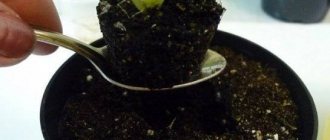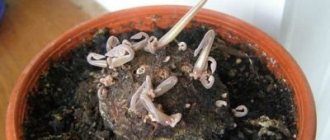What could be easier than growing violet (Saintpaulia)? They live in almost every apartment . But in practice it turns out exactly the opposite. Among collectors, Saintpaulias are considered rather capricious plants.
- Stops blooming;
- Then the leaves stretch out;
- It withers and dies.
Violet leaves droop for various reasons.
Let's look at why this happens in order. We will learn in more detail why the violet dropped its leaves after transplantation and other problems.
Transplanting violets
Preparation
The soil in which it grows is very important for violets. The substrate must be :
Wrong choice of substrate leads to root rotting .
The soil mixture
can be :
- Buy ready-made;
- Take any soil and add sand, vermiculite or perlite;
- Cook it yourself.
Whatever substrate is chosen, it will need to be sifted and baked in the oven for half an hour to destroy:
- Pests;
- And pathogenic bacteria.
Collectors prefer to compose such soil themselves . To do this they take:
- Peat;
- Peat tablets;
- Or coconut substrate in briquettes.
Add 15% sand or perlite, leaf humus or soil from under a birch tree. dry ground horse excrement as a nutrient organic matter , but not much.
The second most important factor in successful planting is the choice of pot . For a small violet, the diameter of the container should be 5-6 cm, for an adult plant - 10-12 cm. But in order not to be mistaken, since violets can be:
Before transplanting the violet, you need to choose a pot.
You should select a pot 1/3 of the diameter of the rosette. It is desirable that the height and width of the container approximately coincide . Ceramic pots are also not recommended, since the clay can cool or heat up greatly depending on the temperature on the windowsill, which has a detrimental effect on the root system of Saintpaulia. If you choose a larger container, the violet will not bloom.
Periodicity
It is recommended to replant violets every 2-3 years. But it is best to do this when the roots completely entangle the earthen ball. This event should be carried out in April - June, in this case the transplant will be more successful :
- There is enough light outside the window;
- On the windowsill at night the temperature does not drop below +18 degrees.
Before transplanting, the plant needs to be watered a little . This is done so that the fragile and sensitive roots of the violet are less injured.
Technology
Carefully remove the violet from the pot and lightly shake off the soil . Remove the lower wilting leaves by sprinkling the removal area with activated carbon. If an adult plant is replanted, then the old pot:
- It is cleared of old soil;
- Scalded with boiling water;
- And fresh drainage and soil are poured there.
In the case when a young Saintpaulia is transplanted, another container of the appropriate size is selected.
Next, the plant is watered so that the soil is distributed evenly , there are no voids and all the roots are in the ground. For prevention, you can pour not plain water, but a solution of Fitosporin and Zircon, 1 ml each. per liter of liquid. The water must be allowed to drain well.
Place a plastic bag or a cut plastic bottle on the flower There is no need to place Saintpaulia on a windowsill, as cold air or drafts can damage the plant. The temperature day and night should be 20-24 degrees. It is best to place the violet on a shelf under fluorescent lamps.
But many beginners ask the question: why doesn’t violet grow after transplantation? Let's find out in more detail why this happens.
Possible problems
I wonder what to do if the violet withers? Not only beginners, but also experienced collectors are faced with the fact that after transplanting violets lose their turgor very much, begin to die and have to be re-rooted.
The violet may not survive the transplant.
There can be many reasons why violet leaves drooped after transplantation, but there are three main ones :
- Lack of light;
- Overwatering;
- Low temperature.
drooping leaves
In what case do Saintpaulia leaves lose turgor? When the roots don't work. This can happen if :
- The plant was dried;
- The flower was watered too often and abundantly, the roots rotted.
In the first case, you can try to revive the violet:
- Take a container of larger diameter;
- Pour water with zircon and phytosporin;
- Immerse the pot with the plant there for an hour;
- Let the water drain;
- Place a plastic bag on the violet;
- And put it in a dark place for several days. The temperature there should be 22-24 degrees.
If this does not help, then Saintpaulia, as in the second case, will have to be re-rooted . The roots are removed, the trunk is cleaned and either placed in a container of water in which an activated carbon tablet is dissolved. Or they are immediately placed in damp peat under a bag.
Why do violets' leaves droop?
Improper watering leads to problems with roots. If the soil is too dry, thin roots die , which leads to the fact that the root system cannot absorb water. Otherwise, if the earthen ball is over-moistened, the roots may begin to rot . In both cases, the leaves droop and lose turgor.
CAREFULLY! Particularly dangerous is first overdrying and then overwatering the plant. This happens when, having discovered an overdried violet, abundant watering is carried out. In such a situation, the root system cannot cope with a large amount of water and the process of rotting begins.
A pot that is too small or too large will also cause drooping leaves:
- When growing Saintpaulia in a pot that is too small, timely watering is very important, the plant dries out very quickly , and the process of roots dying begins;
- otherwise, if there is a large container, the roots cannot cope with the volume of water. The soil remains wet for a long time, the roots cease to function fully. And as a result, the leaves of the plant drop.
For violets, the size of the pot is very important.
Hypothermia and very high temperatures have a detrimental effect on Saintpaulia:
- hypothermia most often occurs in the fall when the house has become cold and the batteries have not yet been turned on, or in the spring in a similar situation when the batteries have already been turned off. Also, a sharp drop in temperature occurs during ventilation. In this situation, the root system suffers;
- overheating most often occurs on the windowsill, the sun's rays penetrating through the glass intensely heat the violet, it begins to rapidly lose moisture, the leaves become sluggish, lose turgor, and droop. The more humid the room, the easier the violets tolerate overheating.
The recommended maintenance temperature for Saintpaulia is 20-22 degrees ; at night the temperature should not drop sharply, by no more than three degrees.
In the case when the lower tier of leaves begins to fall, a possible reason may be the venerable age of the violet . In such a situation, if nothing is done, the lower leaves will gradually die off. The violet will look like a “palm” on a curved stem. The root system will not cope with its functions and the leaves will shred and wither.
Drooping leaves may also indicate that the pot contains heavy, compacted soil. This situation occurs most often among beginners when purchasing purchased soil and using it without raising agents.
Such soil becomes dense over time; when watering, water sits on the surface for minutes without being absorbed. In such soil, the roots of violets cannot breathe and develop.
ATTENTION! To diagnose the problem, you need to carefully examine the plant and the soil and pot. To identify the cause, you should also remember what has changed in the conditions of detention recently.
Wrong choice of soil
When inspecting the soil, you need to pick up the pot and estimate its weight. If the soil itself is light, the soil is dry, light to the touch and lags behind the walls, then this is a case when the soil is overdried. If the pot is heavy and wet to the touch, you need to remove the earthen lump from the pot and inspect it.
Signs of rotting of the root system are the appearance of a smell of rot and mold , dark brown or black color of easily detachable roots. Healthy roots are white or light brown in color, quite strong and elastic. If the soil looks like one lump, the finger enters it with difficulty, the water does not absorb for a long time - this is a case of heavy, compacted soil.
When inspecting the rosette, you need to compare its diameter with the size of the pot. The rosette should be three times the size of the pot . If the pot is different in size, then it is small or too large for the plant.
The rosette should be larger than the pot.
The age of the violet should be assessed; if it grows for more than three years, it is considered old.
Hypothermia or overheating
Hypothermia or overheating should be assessed by the external conditions in which Saintpaulia is located. You can put a thermometer next to the pot; the window sills can be warmer or colder than the temperature in the room.
It is necessary to remember whether ventilation was done when the air temperature was low outside, and whether Saintpaulia was standing too close to the radiators. In case of hypothermia from drafts, specific spots appear on the leaves. When overheated, the violet becomes lethargic, with drooping leaves and there may even be burns on the leaves.
IMPORTANT! After diagnosing the problem, take a series of measures to eliminate it. They are naturally different in each situation.
In case of hypothermia, it is recommended to re-root the plant , place it in a warmer place or on a heat-insulating stand and avoid direct flow of cold air.
If the leaves droop due to overheating, what should you do? To begin with, you should try to first put the plant in a greenhouse , watering moderately as necessary.
If leaf turgor does not recover within 2-3 days, the plant should also be re-rooted .
In the future, you should move the violet to a cooler place or shade it from direct sunlight.
Overdrying
If there are signs of soil drying out, it is necessary to determine how long the Saintpaulia plant has not been watered. If one watering is missed, you can moisten the soil as usual . However, if it is very dry, you need to water the plant very little , about one spoon of water and put it in a greenhouse.
Over the next two weeks, watering should be light so that new thin roots grow and the leaves become elastic. If turgor is not restored, it is necessary to re-root the plant.
Overmoistening
When over-watering, it is necessary to remove excess water as quickly as possible ; for this, use napkins or newspapers. You can wrap them around a ball of earth or place a pot on them and change them as they get wet. Next, you need to dry the soil and inspect the plant:
- if the bottom row of leaves begins to rot, you need to remove them and cut off part of the trunk . If the cut has no signs of rot, you can plant the violet in a suitable-sized pot with loose, fresh soil. If the cut is brown, you need to cut it back to healthy tissue . It is also recommended to root the leaf;
All rotten areas of a flooded violet must be removed.
- If there are no signs of decay, it is recommended to transplant the violet into fresh soil . Experienced collectors, as a rule, immediately re-root the violet without expecting further problems.
Wrong size pot
If the pot size is not suitable, it must be replaced. The size of the pot should be three times smaller than the diameter of the rosette . If the pot is changed to a larger one, you can replant the plant by transshipment. If it is smaller, the transplant is carried out as usual. If there are a large number of roots, you can partially remove them.
Other reasons
If the plant is old, you should estimate the length of the trunk; if the length is short, you can simply remove the bottom row of leaves and deepen the trunk. If there is a palm tree, it is necessary to re-root the plant by cutting off the trunk to a length of no more than two centimeters and peeling it like a carrot.
ADVICE! If you use unsuitable soil, you should replant the plant in light soil with the addition of baking powder.
Sometimes a situation arises when the leaves are healthy, strong and turgor, but for some unknown reason they hug the pot. The reason for this may be excessive light; the leaves try to move as far away from the light source as possible.
In this situation, you can shade the plant from direct sunlight by gluing parchment paper to the glass or moving it away from the light source on a shelf.
You can also cut a circle around the diameter of the rosette from plain white paper and place it on top of the Saintpaulia.
It is also worth noting that different varieties of violets require different amounts of light , so lighting conditions should be selected for each individually, depending on the behavior of the leaves.
Aftercare
The violet is such a fragile, delicate and capricious plant that the main method of eliminating errors in care is to replant the flower. To minimize the resuscitation period, you must strictly follow simple rules :
- Quite bright, but diffused light;
- Lighting duration is 10-12 hours a day;
- The temperature is 18-24 degrees without sudden changes and drafts;
- Proper watering, that is, regularly and moderately. The soil should always be moist, but not wet.
A few more useful tips, following which you will need to replant Saintpaulia no more than once every 2-3 years :
- To make the rosette beautiful, after each watering, turn the flower 45 degrees relative to the light source;
After transplantation, the violet requires good care.
With these simple manipulations, the violet will be healthy and beautiful for a long time .
Corrective Action
Now we have figured out the main reasons for leaf curling, now we just need to learn how to eliminate them.
Eliminating the consequences of the flood
The first thing to do when a flood occurs is to carefully transfer the violet to another pot with drier soil. In this case, it is necessary to cut out all rotten places on the root system. If the symptoms of flooding have just begun to develop, you can get by by drying the earthen clod and loosening it.
You should also check for drainage holes. To prevent flooding in the future, you need to follow these simple rules:
- Water only after the top layer of soil has dried out.
- Watering is best done from a tray
- After watering, be sure to drain excess water from the tray.
Fighting ticks
The cyclamen mite is a rather dangerous and difficult to remove pest. Its destruction must be approached comprehensively. The first thing to do is isolate the infected plant. It should be noted right away that it will most likely not be possible to save a very heavily infected violet.
The next thing to do is to remove all severely damaged leaves on the plant. After this, treatment with special acaricide preparations begins. For example, in indoor conditions you can use Fitoverm. There is no point in using traditional insecticides against ticks; they will be ineffective in combating them.
Video on how to fix problems with violets:
Restoring the lighting and fertilizer regime
For successful development, violets require soft, diffused lighting. If this condition is violated, its leaves begin to deform. When keeping plants under lamps, the duration of daylight hours should not exceed 12 hours. And the lamps themselves should be located above the plants at a height of 25-30 cm.
The fastest way to eliminate overfeeding is to transfer it to fresh soil. To prevent this from happening in the future, it is best to purchase a special substrate for growing violets.
When applying fertilizers, you should strictly observe the required dosage and frequency of use. When using universal mineral fertilizers for feeding, it is recommended to reduce their dosage by half.
We help the plant adapt after transplantation
If the transplant went wrong, the plant needs help to adapt to the new location. To do this, immediately after transplanting, the pot is placed in a dimly lit place for several days. Also, for easier adaptation, a greenhouse effect can be created for the plant. To do this, you can cover it on top with a plastic bag. Various immunostimulants have a good effect.
For example, you can use Epin or Zircon. To prevent leaves from curling in the future, you must strictly follow all necessary care measures, select the correct watering and lighting conditions, and also periodically inspect the plant for pests.
Reasons why violets may dry out
The difficulty is that it can be difficult to immediately decide what the problem is. Violet, in general, is very capricious and can express any discomfort through an unhealthy appearance.
And yet there are the most likely reasons why the leaves of the plant begin to dry out.
Too much sun
Saintpaulia is a heat-loving plant, its homeland is Africa. But the flower does not tolerate direct sunlight. In its homeland, violet grows in the thick of the jungle and on the slopes of mountains, but not on the southern side, but where direct exposure to the sun is not so long.
If your pot is on a south-facing windowsill and the sun shines into the room most of the day, the violet may not like it. Its delicate leaves simply burn under the rays. They quickly begin to turn yellow and dry out.
To save Saintpaulia, move the pot to a place where there is a lot of light, but there is no direct sunlight.
Overfilling or underfilling
If the leaves of a violet turn black, this indicates excessive watering. Darkening usually starts at the ends. Gradually the entire leaf begins to wither and falls off. When there is too much water and the soil does not have time to dry out, the violet roots begin to rot.
If you notice blackening, you should definitely check the roots. Carefully dig the plant out of the soil. If rotten roots are detected, you need to remove all spoiled remains and replant the plant in a fresh substrate.
With a lack of moisture, the leaves turn brown, turn yellow, become dry, and shrink. Actually, any plant will begin to dry out when it is not watered for a long time.
The peculiarity of violets is that they instantly react to any factor that causes them inconvenience.
In this case, it is enough to normalize the watering of the Saintpaulias and they will return to normal.
Pests
Drying of the leaves can be caused by mites. They often nest on the underside of leaves, and their sizes are so small that they are almost invisible to the eye. The leaves begin to become covered with yellow-brown spots on top and gradually dry out.
Why does a violet lift its leaves up?
The condition of the leaves of a houseplant will tell you a lot about what it is missing at the moment of development. A healthy violet has horizontal leaves. A rosette of flowers fits on them, like a miniature bouquet.
If the leaves have risen up, then the reason for this lies in:
- insufficient lighting or its one-sidedness
- dry indoor air
- frequent change of place where Saintpaulia grows
- depletion of soil in a pot
Depending on the amount of light, the plant begins to change the position of its growing point. When there is little daylight, the leaves stretch out, trying to get it. Direct sunlight leads to the fact that the violet begins to hide the growing point, covering it with the surface of the plates.
In winter, air humidity drops sharply, and Saintpaulias bloom poorly, and the leaves, rising, cover the formed buds from drying out.
The flower reacts to a change in location by raising its leaves. Only after getting used to some conditions, you have to adapt to others. A lack of nitrogen in the soil affects the condition of the leaves and their proper development.
Along with a change in the direction of the growth point of the leaf rosette, the leaf plate may twist. This situation is typical for poor soil in a pot. Often the foliage turns pale, dries out and falls off. Here, the cause of this situation may be infections or a pest attack on a houseplant.
General advice on what to do if a violet withers and dries
- Remove damaged leaves immediately; they will not recover anyway, and the plant will have to spend a lot of energy maintaining their vital activity.
- If you find signs of disease, remove the violet away from other flowers, as there may be pests on it and your neighbors risk infecting them too.
- Regardless of the cause of the disease, it is better to transplant the flower into a new substrate.
- Violets are very sensitive to microclimate; it must be stable. Avoid room temperature changes, drafts, and stuffiness.
- Water only with purified warm water.
- Bathe your violets from time to time, this will support their immunity.
- In winter, heat-loving plants are especially vulnerable; monitor them carefully.
Even a very experienced florist will not be able to immediately tell you why the violet is drying up. You will have to carefully review every possible cause and change the conditions of care.
It is not always possible to save the plant. But even if things are bad, you can try to revive the cutting by cutting it at the root, removing most of the leaves and placing it in water so that it takes on new roots. Very often in such cases the violet begins a second life.
Add a comment Cancel reply
You must be logged in to post a comment.
Found a mistake? Report it: 1) Select the error with the mouse 2) Press CTRL+Enter. Read more.
After replanting, the lower leaves began to wither, laying on the edge of the pot, rotting either from the stem or from the end of the leaf.
I transplanted it just a few days ago and not only this violet, but several, all the others don’t have this. This didn't happen before.
I have already cut off several leaves, please tell me what it could be. I'm very sorry for the plant.
The photo quality is not very good, but you can still see that this is not normal.
- Login or register to post comments
- print version











